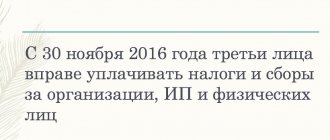The application for registration of an individual entrepreneur does not provide a field for selecting a tax regime, therefore, immediately or within a month from the date of registration, an entrepreneur can submit a separate notification about the transition to one of the available special regimes, then the start date of its application will be the date of registration.
If such an application is not submitted, then the individual entrepreneur automatically retains the general tax system (OSNO).
Below we will analyze in detail all possible taxation systems for individual entrepreneurs in 2021.
Insurance premiums for individual entrepreneurs “for themselves”
An individual entrepreneur must pay insurance premiums “for himself” (fixed payments) under any taxation system, even if he does not conduct any activity and does not receive any profit. If an individual entrepreneur works alone (without employees), then he must pay contributions only “for himself.”
During 2021, an entrepreneur needs to make 2 payments:
| For pension insurance | For health insurance | Total |
| RUB 32,448 | RUB 8,426 | RUB 40,874 |
Also, individual entrepreneurs whose annual income for 2021 will be more than 300,000 rubles will have to pay an additional 1% of the amount of income exceeding these 300,000 rubles until July 1 of the next year.
For more details, see the page about fixed payments for individual entrepreneurs.
Features of the simplified tax system
Taxpayers under the simplified tax regime are recognized as both individual entrepreneurs and organizations. To switch to this tax regime, you need to meet certain requirements.
General terms
- number of employees less than 100 people;
- the activity is not related to the production of excisable goods - with the exception of wines, wine materials and other products made from its own raw materials;
- there is no work on the extraction and sale of minerals;
- annual income does not exceed 150 million rubles.
Additionally, conditions are provided for organizations. To be more precise, selection for “simplified” jobs is carried out based on the number of employees, type of activity and annual profitability.
Particular attention should be paid to the fact that from 01/01/2021, serious changes will come into force regarding the limits for individual entrepreneurs and LLCs, giving the right to operate on the simplified tax system (Federal Law No. 266 of 07/31/2020). Let's take a closer look at them.
Taxes and contributions from employee salaries
An individual entrepreneur can hire workers under labor and civil law contracts (contractor agreement, contract for the provision of services and others, for one-time work or work that does not require compliance with internal regulations).
It is important to understand that when hiring an employee, an individual entrepreneur takes on additional costs and responsibilities:
- Calculates and withholds personal income tax on income paid to its employees. Once a month (the day after payment of wages), an individual entrepreneur is obliged to transfer personal income tax to the tax office, acting as a tax agent.
- Pays insurance premiums. Contributions for employees are paid every month, based on the size of insurance premium rates multiplied by employee salaries.
Learn more about taxes and insurance payments for employees.
Read about how to find out about tax debts here.
note
, from 2021, all insurance premiums, both fixed and for employees, are paid according to the details of the Federal Tax Service of the Russian Federation. This is due to the transition of the administration of insurance premiums to the introduction of the Federal Tax Service from 2021.
Tax calculation for simplified tax system
There are two objects of taxation on the simplified tax system:
- “Income” - 6% of “dirty” profit;
- “Income minus expenses” - 15% (“net” profit).
Individual entrepreneurs have the right to choose any scheme that is beneficial in their opinion. It must be indicated once a year. It will be possible to change the object of taxation only after the end of the annual period.
Note! Participants in a simple partnership agreement or trust management of property can calculate tax only on “net” profit.
For individual entrepreneurs working under the “Income minus expenses” scheme, a “minimum tax” is provided. It is 1% of the tax base calculated under the “Income” object. If, at the end of the reporting period, the entrepreneur’s tax amount is less than the minimum, he will have to pay 1% of the “dirty” income.
Example. Net profit for the reporting period amounted to 400,000 rubles, and together with expenses - 2 million rubles. The tax is calculated as follows: 400,000 * 15% = 60,000 rubles. At the same time, the minimum tax is calculated: 2,000,000 * 1% = 20,000 rubles. The amount to be paid is 60 thousand rubles, so it is higher.
| Read and ask questions: Tax holidays for individual entrepreneurs in 2021 |
Taxes depending on the chosen taxation system
In total, there are five tax regimes for individual entrepreneurs (one general and four special):
- The general taxation system is OSN;
- Simplified taxation system - simplified tax system;
- Patent taxation system - PSN;
- Unified agricultural tax - Unified Agricultural Tax.
- Professional income tax – NIP.
You can learn more about each tax regime in force in Russia on this page.
Limits on the simplified tax system in 2021
In 2021, two sets of limits for the simplified tax system will come into effect:
- basic, familiar to entrepreneurs;
- elevated.
Compliance with the basic limits gives the right to individual entrepreneurs using the simplified tax system to pay tax at standard rates, as in 2021. Higher limits require you to make payments at higher rates.
| Limit | Base | Elevated |
| Annual income, in rubles | 150 million | 200 million |
| Number of employees, people | 100 | 130 |
Checking for compliance with limits is carried out in the usual form:
- income is calculated throughout the year (results are summed up at the end of each quarter);
- The number of employees for each reporting period is calculated.
The obtained values are compared with acceptable values. If they exceed the basic limits, it is worth moving to another level. If the data exceeds even the increased limit, the simplified tax system will have to be abandoned and switched to the general taxation regime.
Additional taxes and payments for individual entrepreneurs
Certain types of activities require the payment of additional taxes. These include:
- Tax on the production and sale of excisable goods.
- Mineral extraction tax (MET).
- Water tax for the use of water bodies.
Individual entrepreneurs with special permits and licenses, in addition to additional taxes, must also carry out:
- Regular payments for the use of subsoil.
- Fees for the use of wildlife objects.
- Fees for the use of aquatic biological resources.
Note
: Additional taxes, fees and charges must be paid regardless of the tax system in which the individual entrepreneur is located.
Read about how to pay taxes and fees online here.
Tax rates under the simplified tax system in 2021
Let us remind you that individual entrepreneurs using the simplified tax system in 2021 pay income tax according to the standard limit. With another limit coming into effect in 2021, some businesses will face higher rates.
The table clearly shows the tax rates that begin to apply from 01/01/2021.
| Object of taxation | Tariff with basic limits | Tax rate at higher limits |
| "Income" | 6% | 8% |
| "Income minus expenses" | 15% | 20% |
What is IP income
Not only the main activity brings money to enterprises and entrepreneurs. Income is generated from all receipts reduced by material costs, from which wages are excluded.
Income and expenses in the declaration
Costs related to cost include:
- depreciation;
- raw materials and materials, fuel and electricity. Finding them in the expense column is easy;
- social contributions for extra-budgetary funds;
- salary.
Income includes profit and labor costs. If a business has no material costs, then it is equal to revenue from sales of products. An individual entrepreneur can figure out how to find out turnover without any problems.
Normative base
All aspects of the use of UTII are contained in Chapter 26.3 of the Tax Code of the Russian Federation. Imputation taxpayers can be legal entities and individual entrepreneurs, except for those who fall under the following categories:
- largest taxpayer;
- an entity providing catering services in educational, social and medical institutions;
- company - the share of participation of other organizations in which exceeds 25%;
- an organization whose average number of employees over the last year exceeds 100 people;
- an entrepreneur who rents out gas stations or gas stations.
The single tax on imputed income cannot be used throughout Russia. For example, in Moscow it was canceled back in 2014. Find out what types of activities are subject to imputation in your region.
UTII will be canceled from January 1, 2021. Choose a different tax system for your business using our free calculator. We wrote an article in which we collected expert answers to popular questions about tax regimes, the transition from UTII and online cash registers. If you haven't found the answer to your question, ask it in the comments, we will definitely answer.
Deadlines
The tax period under the simplified tax system is a year.
Reporting periods: first quarter, half year, 9 months. Based on the results of the tax period, entrepreneurs submit a declaration to the tax service. Individual entrepreneurs must meet the deadline by April 30 of the year following the expired tax period.
Entrepreneurs make advance payments throughout the year. Deadlines for paying individual entrepreneur taxes on the simplified tax system in the form of advance payments:
- until 25.04. for the first quarter;
- until 25.07. For half a year;
- until 25.10. in 9 months
Advance payments made during the year are taken into account when calculating the annual tax. The tax amount can be reduced by paying insurance premiums.
Note! Due to the spread of coronavirus infection, the Government has decided to extend the deadlines for submitting declarations and paying taxes.
More details in the summary table.
Preferential rates
Tax benefits for individual entrepreneurs using the simplified tax system are provided for certain categories of taxpayers:
- from 1 to 6% - “Income”;
- from 5 to 15% - from “net” profit.
How to reduce individual entrepreneur taxes on the simplified tax system? The decision to apply preferential rates is made at the local level. In particular, they operate in Crimea. From 2021 to 2021, the rate may be reduced to 3% when calculating tax on “net” income. It is established depending on the type of activity and category of the entrepreneur.
For taxpayers registered for the first time, a tax rate of 0% can be set for two tax periods. This applies to manufacturers, categories operating in the scientific or social spheres, in the field of providing household services to the population and places for temporary residence. The share of income from the sale of goods must exceed 70% of the total profit.
When using a 0% rate, certain restrictions may be imposed on individual entrepreneurs:
- on the number of employees;
- to the maximum amount of profit from sales (reduced by no more than 10 times).
In each region, the rate is considered individually. As a rule, preferential tax payments are established for certain types of activities that require enhanced development in a particular area.
Income accounting for expenses distribution
If different regimes are combined, the following obligations arise:
- maintaining separate records for each of the special regimes. If there are items that cannot be clearly attributed to one of them, the money is distributed proportionally;
- accounting;
- book of income and expenses. This requirement is especially important for those who use simplified language.
It is necessary to rely on the Tax Code, in particular, its Art. 249, 250 and 251. The calculation of the proportion also includes income, which is called non-operating income. Only expenses that do not increase the tax base for the corresponding types of charges are not taken into account.
As payment is made, income from activities on UTII is determined. When making calculations, the accountant must exclude any transactions that remain unpaid.
It is allowed to reduce the amount of UTII accrued for the quarter:
- the amount of insurance premiums that have actually been paid;
- under personal voluntary insurance contracts for employees. They are concluded in case of temporary disability; exact payments must be determined individually;
- paid hospital benefits at the expense of the organization. The identification number is indicated separately.
Important! The total amount of deduction cannot exceed 50% of the amount of tax that has already been paid.
Income and expenses are distributed proportionally to make it easier to calculate the contributions and taxes themselves that require transfer to the budget.









